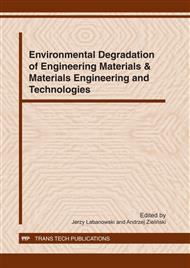p.185
p.193
p.201
p.207
p.215
p.225
p.233
p.241
p.249
Indoor Atmospheric Degradation of Historical Metal Objects Studied by Spectroscopic Techniques
Abstract:
The surface layers resulting from prolonged exposure to the indoor environment and the bulk material of metal artifacts from the collection of National Museum in Gdansk are studied by means of spectroscopic techniques. The composition of the surface layers of the forged iron box lid covered with polychrome (XVI c.), and of the bronze female nude sculpture (antiquity) is obtained from the XRF and µ-Raman spectra. The elemental composition is confirmed by the LIP (Laser Induced Plasma) spectroscopic measurements. The quasi-nondestructive LIP technique applied for stratigraphic sampling performed with an accuracy of ca 2 µm across the multilayer surface coverage reveals such elements as C, Ba and Na in the uppermost layer. From coincidence of the XRF, Raman and LIP data the presence of surface contaminant CaCO3, the corrosion product FeO(OH) and patina Cu2 (OH)3Cl are concluded. It is shown that the complementary spectroscopic analysis allows for the in-depth study of the environmental impact on historical objects and delivers indications for the appropriate strategy of the planned conservation activities. Moreover, from the data collected from the technologies applied in the past, origin, provenance and routing of the artifacts can be concluded.
Info:
Periodical:
Pages:
233-240
Citation:
Online since:
December 2011
Keywords:
Price:
Сopyright:
© 2012 Trans Tech Publications Ltd. All Rights Reserved
Share:
Citation:


